August-September 2015




This Fall we banded 6,030 new birds; sadly, this turned out to be the second lowest capture rate in the last ten years. The pace at the lab didn't seem that much slower though, as we made up for it in recaptured birds (previously banded). Our total of 2,949 recaps made it the best season for recaps in those same ten years, bringing the total number of birds caught in our nets to just under 9,000.
Although the early Fall was on par for an average season, weather in October brought high winds on many banding days which kept more exposed nets closed or forced an early closure of all nets. Of the 30 banding days in October and November, we closed early on almost half (14 days) and our notes reference "increasing wind throughout the session" for another 8 banding days. Since any light breeze can move the nets and make them more visible, even days that were not breezy enough to force us to close surely impacted our capture rates.

Our 6,030 new birds represented 102 different species. Our Top Ten species for the Fall, were: Magnolia Warbler (421), Gray Catbird (359), Swainson's Thrush (327), Dark-eyed Junco (322), Yellow-rumped (Myrtle) Warbler (305), Ruby-crowned Kinglet (296), Ruby-throated Hummingbird (276), White-throated Sparrow (263), American Goldfinch (258) and Song Sparrow (227).
Interestingly, if one includes the recaps, Gray Catbirds outnumbered the Magnolia Warblers by almost 2:1 (totals, Newly banded + Recaps, GRCA:MAWA, 953:535). Also, recaps accounted for frequent captures of Swamp Sparrows and Common Yellowthroats, which made the Top Ten list of Newly banded + Recaps (SWSP at #2 with 440 and COYE at #4 with 396), edging our American Goldfinch and Ruby-throated Hummingbird, of which we caught few recaptures.

For our "Early Fall" photo highlights, we thought it fitting to start with the "Tyrant" flycatchers (family, Tyrannidae) of the genus Empidonax, which migrate through our area almost exclusively in the months of August and September (we banded just two in October). During the infiltration of these small but spunky flycatchers, we banded 178 collectively-- the most common was the Yellow-bellied Flycatcher like the one featured at the left, of which we banded 67.
The Empidonax flycatchers have a well-deserved reputation for confounding even experienced birders who might want to identify individuals of this group, particularly in the Fall when they are in the most basic plumage. Thankfully, in the hand, banders can use other subtle characteristics such as leg color and feather emargination to help separate them by species. This Fall we were able to capture a photo of each Empid as well as an outstretched wing shot. All four individuals photographed were hatch-year birds.

The wing of the hatch-year Yellow-bellied Flycatcher showing all nice fresh feathers in good condition. Most of the adult Empidonax flycatchers (including this species) do not complete their prebasic molt until they reach the wintering ground, which makes it easy to deduce this is a young bird.

We banded 50 Least Flycatchers this Fall (hatch-year pictured at left), earning them the title of second-most-common Empid. These birds have a short wing, a complete eye ring (although less distinct in this juvenal basic plumage) and black legs.

The Least Flycatcher's outstretched wing showing distinct, broad buffy wing bars. Notice that it is overall less yellow than the aptly-named Yellow-bellied Flycatcher.

Traill's Flycatchers (of which we banded 38) are actually two Empidonax species grouped together because their appearance is so similar-- the Alder and Willow Flycatchers can be differentiated in the field by song, but prove almost impossible in the hand except in extreme individuals.

The Traill's flycatcher wing (hatch-year); again, more green than yellow, with buff or yellowish wing bars.

Lastly, the Acadian Flycatcher was our most infrequent Empid; we banded just 23 of these individuals. This is the largest of the Empidonax flycatchers with a long wing, heavier bill and gray legs. As seen in this photo, hatch-year Acadian Flycatchers have a strong yellow wash across the abdomen.

The wing of a hatch-year Acadian Flycatcher, showing the broad buffy tips on the median and greater coverts.

Two other Tyrant Flycatchers we commonly band-- the Eastern Phoebe and the Eastern Wood-Pewee are related to the smaller Empidonax flycatchers but belong to different genera (Sayornis and Contopus, respectively). Both species were present in good numbers this Fall, especially the Eastern Phoebe (on the left in this photo, both hatch-year birds). Notice that the Phoebe is larger and lacks the distinct wing bars of the Wood-Pewee.

We banded 127 Phoebes (79 in the early Fall, 48 in October), almost double our long-time Fall average of 64. Eastern Wood-Pewees migrate through a little earlier than the Phoebes; we banded our last of 37 Wood-Pewees on September 30th (Fall average = 27). In this comparison shot of these two very similar 'flycatchers,' note the diffuse yellow across the breast of the Phoebe (L) and the bi-colored lower mandible of the Wood-Pewee.
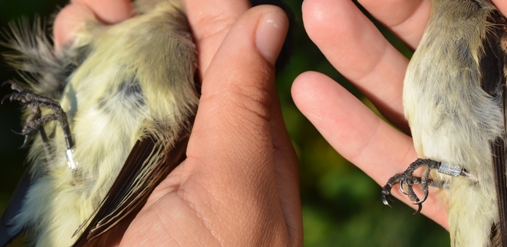
One other characteristic we can use to differentiate these two species is tarsus length. Notice the size of the tarsus in relation to the band in this photo. The tarsus of the Eastern Phoebe (L) is clearly much longer than that of the Wood-Pewee.

We were able to capture photo comparisons of male/female plumages of three warbler species this Fall, starting with this female hatch-year Black-and-white Warbler. The black/white contrast is less distinct in the female of this species, and the female shows some buff coloration in the face and along the flanks.
We banded this female and the male Black-and-White Warbler below on September 15th. They were two of 13 banded this season (7 females and 6 males, the last banded on September 22).

Fairly obvious molt limits of this species usually makes age determination straightforward. Note the much darker, replaced wing coverts and tertiary feathers close to the body; these feathers were replaced in late summer/early Fall after the bird had fledged.
One other useful tool for ageing is the 2nd alula feather (indicated by the arrow in this photo); in young birds, the white on this feather does not wrap completely around the tip, whereas the margin of an adult feather would be completely white.

A hatch-year male Black-and-white Warbler with clean contrasts between the colors and none of the buff tones of the female (above).

The spread wing of the Black-and-White Warbler with a very apparent first prebasic molt; note that, although the second alula feather has more white than the female's, the white still does not wrap around the feather tip.

Coincidentally, we also banded 13 Mourning Warblers this season, six in August and seven in September. This hatch-year female was banded on August 28th.
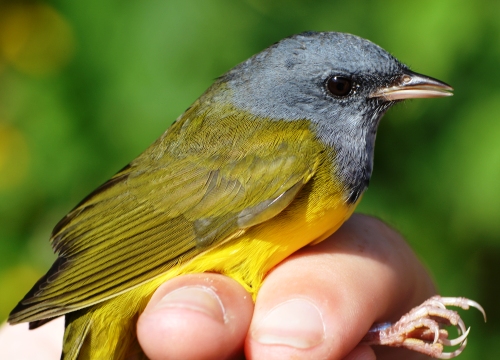
Coincidentally, we also banded 13 Mourning Warblers this season, six in August and seven in September. This hatch-year female was banded on August 28th.

While not a female/male comparison, it seems logical to add this Connecticut Warbler here for comparison to the Mourning Warbler (above).
This adult male Connecticut was banded on September 29 and was one of 24 that we banded this Fall. ded on August 28th.

We banded 26 Cape May Warblers this season. This species' name, Setophaga tigrina, reminds us that the breast is heavily streaked with fine black stripes like that of a 'tiger.' This individual is a hatch-year female that we banded on September 11th.
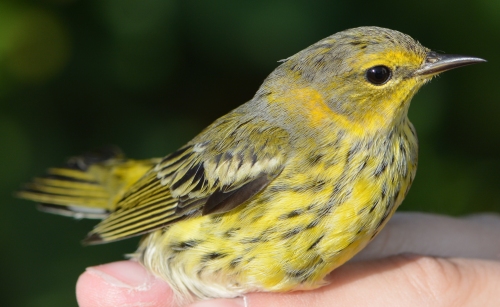
This hatch-year male Cape May warbler, much brighter than his female counterpart (above) was banded on August 26th.

Other warblers, in order by date of banding:
Blackburnian Warbler. This handsome adult male, banded on August 25th, was one of seven we banded this Fall.

A look at the heavy black streaking on the back of the Blackburnian Warbler.

This hatch-year female Bay-breasted Warbler was one of eight that we encountered this Fall; she was banded on August 27th.r.

A young, very nondescript Common Yellowthroat from August 29th. Certainly a more 'common' occurrence in our nets, we banded 175 of these small, wriggly warblers this Fall. Since the black mask and bright yellow throat do not molt in until late Fall, this bird was recorded as 'unknown' sex. h.r.

A hatch-year male Blackpoll Warbler showing its characteristic yellow feet. This bird from September 6th was one of 18 banded at Powdermill this season.sex. h.r.

This hatch-year Western Palm Warbler was banded on September 9th. We banded 21 Western Palm Warblers this Fall and four Yellow Palm warblers. ermill this season.sex. h.r.


Good views of the bright yellow undertail coverts of the Western Palm Warbler as well as the streaking on the head and back and the distinct white markings on the tail.
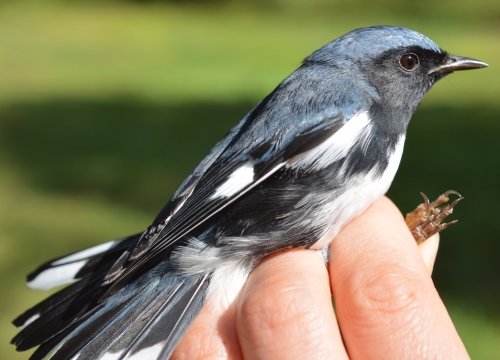
This adult male Black-throated Blue Warbler, banded on September 25 (one of 60) seemed especially photogenic!

Back view of the Black-throated Blue showing light streaking across the back feathers.

Now on to some other interesting captures...
This hatch-year Yellow-bellied Sapsucker from September 23 was one of four that we banded this Fall, in line with our long-tem average of 3.4.
So, how do they get their name? Cornell's All About Birds website explains that this is "an enterprising woodpecker that [drills rows of shallow holes in tree bark] and laps up the leaking sap and any trapped insects with its specialized, brush-tipped tongue"
Since both the male and female of this species have the red patch on the head, sexing these individuals falls to the throat patch. Since none of the throat feathers had been replaced yet, this individual was sexed as 'unknown.'

And speaking of specialization, here's a look at the stiff tail of the Sapsucker. Note the extra-thick rachis (shaft) of the central rectrices. These sturdy tails provide woodpeckers with a handy prop to help stabilize them while hanging on the tree trunk to drill those holes!

We banded two Yellow-breasted Chats this Fall, again on par with our average of 1.6/year. This individual, from August 21st, was a hatch-year that still has a bit of that fleshy gape remaining at the base of the beak; this extra flesh, that allows the young bird to open its mouth wide for feeding will eventually be reabsorbed.
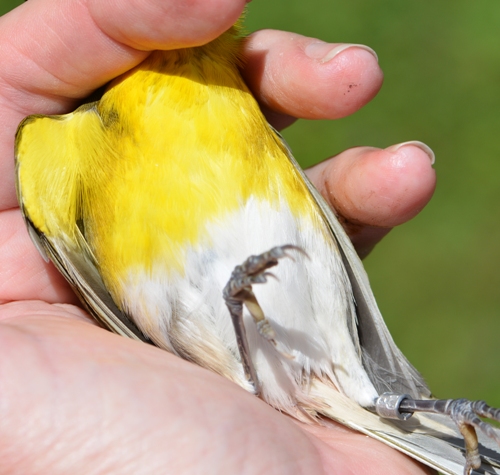
The distinctive abdomen of the chat with it clearly defined yellow and white areas.

The outstretched wing of the Yellow-breasted Chat shows a clear eccentric molt pattern in this photo where the outer six primary flight feathers have been replaced (note the dark feather shafts and the bright green leading edge) as well as the outer five primary coverts. Although harder to see in this photo, the terts and two secondary flight feathers have also been replaced.
Again, this difference in juvenal feathers (grown in the nest) and adult-like feathers grown later in the Fall allows us to age this bird as hatch-year.

Always a star at the banding lab because of their unique and somehow friendly appearance, the cameras always seem to come out for the American Woodcocks.
This hatch-year female, one of two this Fall, was banded on September 24th.ear.

Another infrequent species for us was this Solitary Sandpiper banded on September 1st. This small wading bird can be differentiated from its close relative, the Spotted Sandpiper by the dark 'shoulder' patch visible in this picture. l, was banded on September 24th.ear.

We banded two Yellow-throated Vireos this Fall, this hatch-year bird from September 22nd and one more on September 11th.

This hatch-year male Sharp-shinned Hawk was the only raptor for the entire Fall . He was caught September 15.

Another view of the hawk. His yellow eye clinches his juvenal age class (adults will have a red eye).
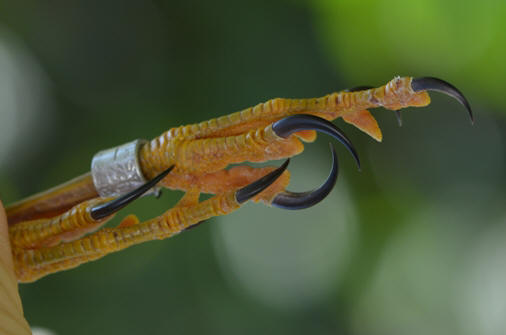
Visitors often ask us about handling the raptors and if we wear gloves when we band them (we do not). Surprisingly, the 'Sharpies' rarely try to bite, but one must always keep an eye on these sharp talons, their first line of defense!


Another helpful eye comparison-- this one of the orbital ring. The area surrounding the eye of a Black-billed Cuckoo starts out greenish or dusky and changes to red over the winter. The hatch-year bird (yellow eye ring) was banded on August 29th; the adult was from August 27th. We would band one more Black-billed Cuckoo on September 18 for a total of three this season.

Now, some owls to close out our "new" bird photo highlights, (keep reading to the end for an interesting recapture story)...
Owls are always a special and rare treat at the lab. If we get one, it's usually just after sunrise or one we have lured into our nets with playback (such as with Project Owlnet, a targeted study of Saw-whet Owl migration).
So, it was a little surprising on August 26th that we caught this young Eastern Screech Owl on our second net check, almost an hour and a half after we had opened the nets.
Hard to tell if he was a little grumpy about being awake at that time of day or just felt he would look more intimidating looking through slits for eyes.
Though this hatch-year owl looks a little scruffy due to the molting of some feathers, they are amazingly soft to the touch.
And, as with the hawks, one must always keep an eye on the feet. Even though this owl has his talons nicely tucked away, they are always ready to lash out at a nearby bander's hand.

And, he did eventually opened his sleepy yellow eyes to see what all the fuss was about.

Since we average less than one Eastern Screech Owl per Fall, we weren't really expecting to see more, much less TWO caught together! As is more typical, these two (also hatch-year birds) were caught just after sunrise on the morning of September 18th. They offered us a good opportunity to show a comparison of the red and gray morphs of this species.
As you can see, both species have plenty of markings that will blend in with their surroundings and provide very good camouflage while they rest during the daylight hours.

A look at the outstretched wings of the red and gray morph Eastern Screech Owls.

In this closeup of the wings, one can see the adaptation of a fringed leading edge that helps this bird achieve soundless flight.tern Screech Owls.

This profile view of our gray morph gives one a good view of the ear tufts. These are clumps of feathers, not related to hearing, the purpose of which is unknown. Some hypotheses are that these tufts are another form of camouflage, a way for owls to recognize each other in low light or they may serve to make the owl look more intimidating.
We weren't intimidated at all, just excited to have an up-close look at three of these amazing birds!Owls.



In the middle of September we held an Advanced Bander Training Workshop at the lab. Participants come from all over the country to learn more about methods used at the Banding Station or to hone skills they may already have.
In the top left photo, Banding Coordinator Luke DeGroote watches over a workshopper gaining proficiency at net extraction.
The bottom two photos highlight a typical morning at the lab with workshop participants puzzling over subtle differences in feathers that aid in ageing the birds.
Workshops are held each year in the Spring and Fall and we do maintain a waiting list. To learn more about Powdermill's workshops, check our page here.

This year, the week of the banding workshop coincided with one of the staff's favorite holidays, "International Talk Like A Pirate Day."
We were fortunate that Luke's cousin from Florida, Captain Red Beard DeGroote stopped by to give us pointers on proper pirate pronunciation.
It turns our that Captain Red Beard is also well-versed in avian molt limits, so he was able to assist with arrrrrducating our workshop participants.
Workshops are held each year in the Spring and Fall and we do maintain a waiting list. To learn more about Powdermill's workshops, check our page here.
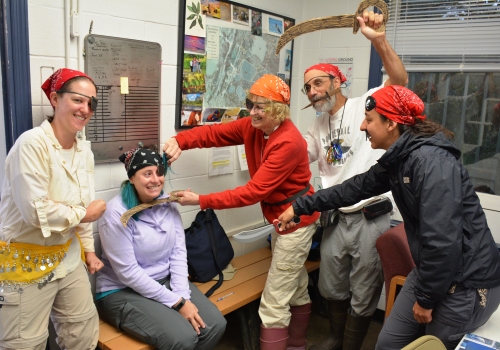
This year, the week of the banding workshop coincided with one of the staff's favorite holidays, "International Talk Like A Pirate Day."
We were fortunate that Luke's cousin from Florida, Captain Red Beard DeGroote stopped by to give us pointers on proper pirate pronunciation.
It turns our that Captain Red Beard is also well-versed in avian molt limits, so he was able to assist with arrrrrducating our workshop participants.
Workshops are held each year in the Spring and Fall and we do maintain a waiting list. To learn more about Powdermill's workshops, check our page here.

Things quickly went arrrrrrrwy and ended with the founder of the banding lab, Bob Leberman, bring threatened at knifepoint until he surrendered.

By the end of the week though, the staff was able to retake the lab and drive out the Pirates just in time for us to pose for the official "Fall Workshop" photo.
Pictured at left are our seven Workshop participants, along with certified trainers Molly McDermott (left, leaning on the sign) and Annie Crary (seated, front and center), Jim and Debbie (faithful volunteers from Virginia, in blue, to left of the sign) and PARC staff members.il he surrendered.

Things quickly went arrrrrrrwy and ended with the founder of the banding lab, Bob Leberman, bring threatened at knifepoint until he surrendered.


We close out this Early Fall update with an adult male Baltimore Oriole. A recap, he showed up in one of our nets on the morning of August 11th. We knew that his band was an older band, but couldn't investigate until later that day.
As it turns out, we banded this bird on May 11, 2007 as an after-second-year, meaning that it was hatched in 2005 or before, making him at least ten years old at this encounter! Amazingly, this is the first time he has been back at Powdermill since 2007.
The National Banding Lab in Maryland keeps longevity records and, while this oriole hasn't broken the record yet (12 years), he is not far off...maybe if he comes back to visit in another couple of years...
